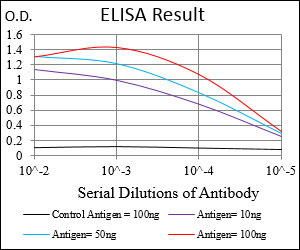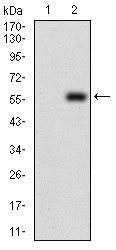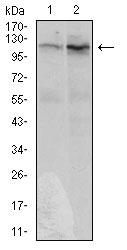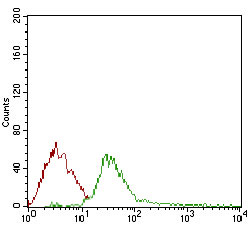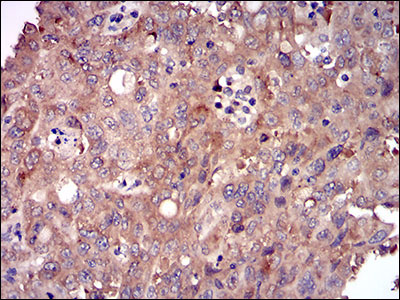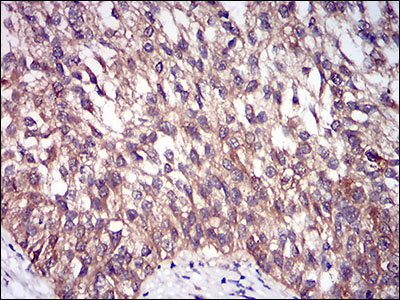DIS3L2 Antibody
Purified Mouse Monoclonal Antibody
- 产品详情
- 实验流程
- 背景知识
Application
| WB, IHC, FC, E |
|---|---|
| Primary Accession | Q8IYB7 |
| Reactivity | Human |
| Host | Mouse |
| Clonality | Monoclonal |
| Clone Names | 6C7B2 |
| Isotype | IgG1 |
| Calculated MW | 99279 Da |
| Description | The protein encoded by this gene is similar in sequence to 3'/5' exonucleolytic subunits of the RNA exosome. The exosome is a large multimeric ribonucleotide complex responsible for degrading various RNA substrates. Several transcript variants, some protein-coding and some not, have been found for this gene. |
| Immunogen | Purified recombinant fragment of human DIS3L2 (AA: 27-250) expressed in E. Coli. |
| Formulation | Purified antibody in PBS with 0.05% sodium azide |
| Gene ID | 129563 |
|---|---|
| Other Names | DIS3-like exonuclease 2 {ECO:0000255|HAMAP-Rule:MF_03045}, hDIS3L2, 3.1.13.- {ECO:0000255|HAMAP-Rule:MF_03045}, DIS3L2 {ECO:0000255|HAMAP-Rule:MF_03045}, FAM6A |
| Dilution | WB~~1/500 - 1/2000 IHC~~1/200 - 1/1000 FC~~1/200 - 1/400 E~~1/10000 |
| Storage | Maintain refrigerated at 2-8°C for up to 6 months. For long term storage store at -20°C in small aliquots to prevent freeze-thaw cycles. |
| Precautions | DIS3L2 Antibody is for research use only and not for use in diagnostic or therapeutic procedures. |
| Name | DIS3L2 {ECO:0000255|HAMAP-Rule:MF_03045} |
|---|---|
| Synonyms | FAM6A |
| Function | 3'-5'-exoribonuclease that specifically recognizes RNAs polyuridylated at their 3' end and mediates their degradation. Component of an exosome-independent RNA degradation pathway that mediates degradation of both mRNAs and miRNAs that have been polyuridylated by a terminal uridylyltransferase, such as ZCCHC11/TUT4. Mediates degradation of cytoplasmic mRNAs that have been deadenylated and subsequently uridylated at their 3'. Mediates degradation of uridylated pre-let-7 miRNAs, contributing to the maintenance of embryonic stem (ES) cells. Essential for correct mitosis, and negatively regulates cell proliferation. |
| Cellular Location | Cytoplasm. Cytoplasm, P-body |
For Research Use Only. Not For Use In Diagnostic Procedures.
Provided below are standard protocols that you may find useful for product applications.
BACKGROUND
The protein encoded by this gene belongs to a small class of the protein tyrosine phosphatase (PTP) family. PTPs are cell signaling molecules that play regulatory roles in a variety of cellular processes. PTPs in this class contain a protein tyrosine phosphatase catalytic domain and a characteristic C-terminal prenylation motif. This PTP has been shown to primarily associate with plasmic and endosomal membrane through its C-terminal prenylation. This PTP was found to interact with the beta-subunit of Rab geranylgeranyltransferase II (beta GGT II), and thus may function as a regulator of GGT II activity. Overexpression of this gene in mammalian cells conferred a transformed phenotype, which suggested its role in tumorigenesis. Alternatively spliced transcript variants have been described. Related pseudogenes exist on chromosomes 11, 12 and 17. ;
REFERENCES
1. Nat Rev Mol Cell Biol. 2013 Jun;14(6):328. 2. Nat Genet. 2012 Feb 5;44(3):277-84.
终于等到您。ABCEPTA(百远生物)抗体产品。
点击下方“我要评价 ”按钮提交您的反馈信息,您的反馈和评价是我们最宝贵的财富之一,
我们将在1-3个工作日内处理您的反馈信息。
如有疑问,联系:0512-88856768 tech-china@abcepta.com.























 癌症的基本特征包括细胞增殖、血管生成、迁移、凋亡逃避机制和细胞永生等。找到癌症发生过程中这些通路的关键标记物和对应的抗体用于检测至关重要。
癌症的基本特征包括细胞增殖、血管生成、迁移、凋亡逃避机制和细胞永生等。找到癌症发生过程中这些通路的关键标记物和对应的抗体用于检测至关重要。 为您推荐一个泛素化位点预测神器——泛素化分析工具,可以为您的蛋白的泛素化位点作出预测和评分。
为您推荐一个泛素化位点预测神器——泛素化分析工具,可以为您的蛋白的泛素化位点作出预测和评分。 细胞自噬受体图形绘图工具为你的蛋白的细胞受体结合位点作出预测和评分,识别结合到自噬通路中的蛋白是非常重要的,便于让我们理解自噬在正常生理、病理过程中的作用,如发育、细胞分化、神经退化性疾病、压力条件下、感染和癌症。
细胞自噬受体图形绘图工具为你的蛋白的细胞受体结合位点作出预测和评分,识别结合到自噬通路中的蛋白是非常重要的,便于让我们理解自噬在正常生理、病理过程中的作用,如发育、细胞分化、神经退化性疾病、压力条件下、感染和癌症。
